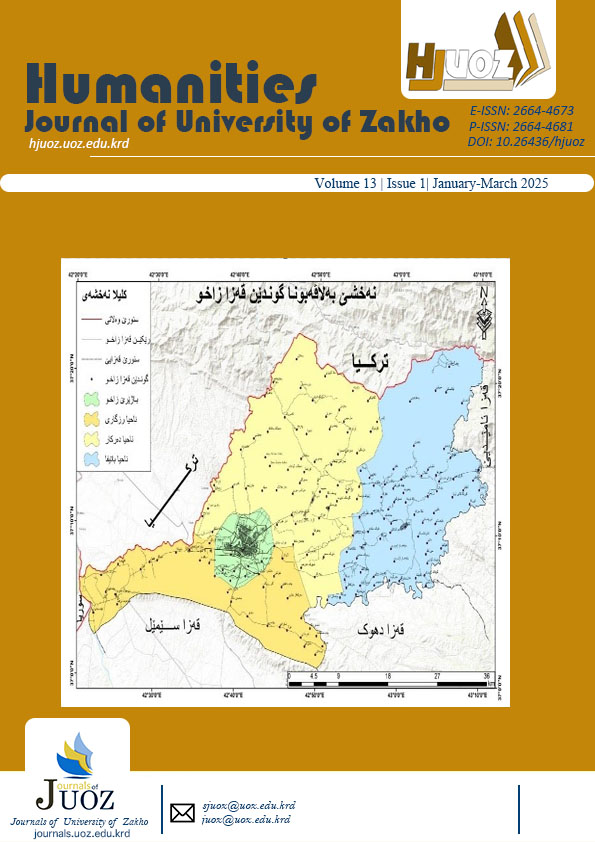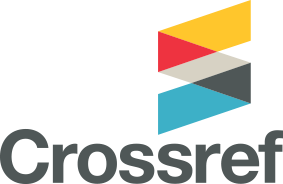THE ROLE OF GENDER IN THE USE OF LANGUAGE IN ONLINE INTERACTIONS: KURDISH INTERLOCUTORS AS NON-NATIVE ENGLISH SPEAKERS
DOI:
https://doi.org/10.26436/hjuoz.2025.13.1.1473Keywords:
Gender, Language, Online Interactions, Ritualized Utterances, language strategiesAbstract
This study examines the influence of gender on the use of English by Kurdish as non-native English speakers in online Interlocutors. It aims at figuring out the contributive role of language to the identification of the interlocutors’ gender, determining the influence of cultural norms on shaping the online communication patterns of Kurdish interlocutors(males and females), and identifying the frequency use of the essential linguistic elements, strategies and styles that distinguishes males’ interactions from females’. This study employs a mixed method, quantitative and qualitative, in the process of data analysis. It is quantitative for administrating a Likert-Scale questionnaire to investigate the perceptions of Kurdish as non-native English speakers according to gender and its influence on the interactions conducted online. It is also qualitative for analyzing one hundred instant messages extracted from males and females’ interactions held in three Telegram public channels. The most two significant concluding points that this study has come up with are: (1) gender diversity affects all the aspects of language including word choice, strategy and style in online interactions, and (2) the frequency of using hedge devices, empty adjectives, euphemistic expressions, apologies, justifications, minimal responses, emoticons, tag-questions, rhetorical questions, intensifiers and exclamatory expressions used by females is far more compared to males. However, males use humor and sarcastic expressions far more compared to females.
Downloads
References
Alahmadi, W., Rabab’ah, G.H.A.L.E.B. & Alghazo, S., 2024. Gender Differences in Language Use in Talks at Google. Kemanusiaan, 31(1), pp. 149–176.
Baron, N.S., 2008. Always on: Language in an Online and Mobile World. Oxford University Press.
Bilous, F.R. & Krauss, R.M., 1988. Dominance and Accommodation in the Conversational Behaviours of Same-and Mixed-gender Dyads. Language & Communication, 8(3-4), pp.183-194.
Coates, J., 2015. Women, Men and Language: A Sociolinguistic Account of Gender Differences in Language. Routledge.
Coupland, N., Coupland, J., Giles, H. & Henwood, K., 1988. Accommodating the Elderly: Invoking and Extending a Theory1. Language in society, 17(1), pp.1-41.
Fattah, B.O., 2020. Giving and Interpreting Compliments in English and Kurdish: Private-sector Workplace as a ample. Koya University Journal of Humanities and Social Sciences, 3(1), pp.21-30.
Fitzpatrick, M.A., Mulac, A. & Dindia, K., 1995. Gender-preferential Language Use in Spouse and Stranger Interaction. Journal of Language and Social Psychology, 14(1-2), pp.18-39.
Fox, A.B., Bukatko, D., Hallahan, M. & Crawford, M., 2007. The Medium Makes a Difference: Gender Similarities and Differences in Instant Messaging. Journal of Language and Social Psychology, 26(4), pp.389-397.
Herring, S.C., 1993. Gender and Democracy in Computer-mediated. Computerization and Controversy: Value Conflicts and Social Choices, 3(2), pp.476-489.
Holmes, J., 1988. Paying Compliments: A Sex- preferential Politeness Strategy. Journal of pragmatics, 12(4), pp.445-465.
Lakoff, R., 1973. Language and Woman's Place, Language in Society, 2(1), pp.45-79.McMillan, J.R., Clifton, A.K., McGrath, D. and Gale, W.S., 1977. Women's language:Uncertainty or Interpersonal Sensitivity and Emotionality? Sex Roles, 3, pp.545-559.
Mulac, A. and Lundell, T.L., 1980. Differences in Perceptions Created by Syntactic‐semantic Productions of Male and Female Speakers. Communications Monographs, 47(2), pp.111- 118.
Mulac, A., Studley, L.B. and Blau, S., 1990. The Gender-linked Language Effect in Primary and Secondary Students' Impromptu Essays. Sex Roles, 23, pp.439-470.
Jackson, L.A., Ervin, K.S., Gardner, P.D. and Schmitt, N., 2001. Gender and the Internet: Women Communicating and Men Searching. Sex roles, 44, pp.363-379.
Johnson, R.D., 2011. Gender Differences in E- learning: Communication, Social Presence, and Learning Outcomes. Journal of Organizational and End User Computing, 23(1), pp.79-94.
Tannen, D., 1990. You Just Don't Understand: Women and Men in Conversation. William Marrow.
Walther, J.B., 1996. Computer-mediated Communication: Impersonal, Interpersonal, and Hyperpersonal Interaction. Communication Research, 23(1), pp.3-43
Published
How to Cite
Issue
Section
License
Copyright (c) 2025 Bikhtiyar O. Fattah

This work is licensed under a Creative Commons Attribution-NonCommercial-ShareAlike 4.0 International License.
Authors who publish with this journal agree to the following terms:
- Authors retain copyright and grant the journal right of first publication with the work simultaneously licensed under a Creative Commons Attribution License [CC BY-NC-SA 4.0] that allows others to share the work with an acknowledgment of the work's authorship and initial publication in this journal.
- Authors are able to enter into separate, additional contractual arrangements for the non-exclusive distribution of the journal's published version of the work, with an acknowledgment of its initial publication in this journal.
- Authors are permitted and encouraged to post their work online.

















